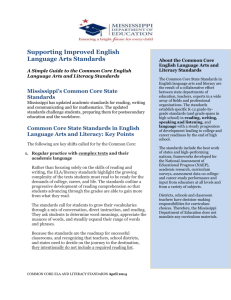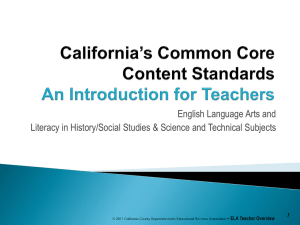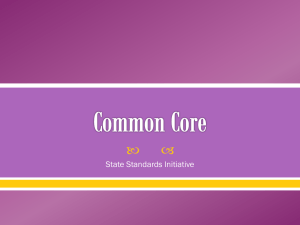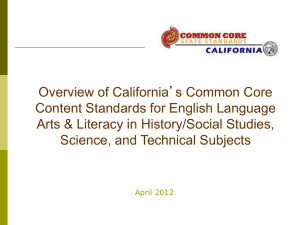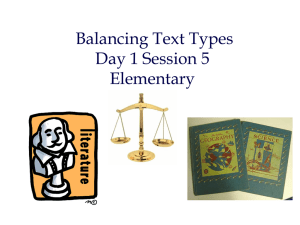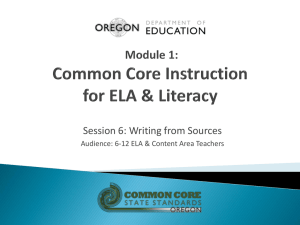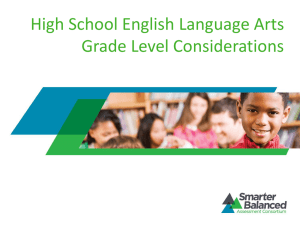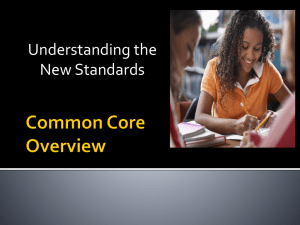ELA General Overview
advertisement
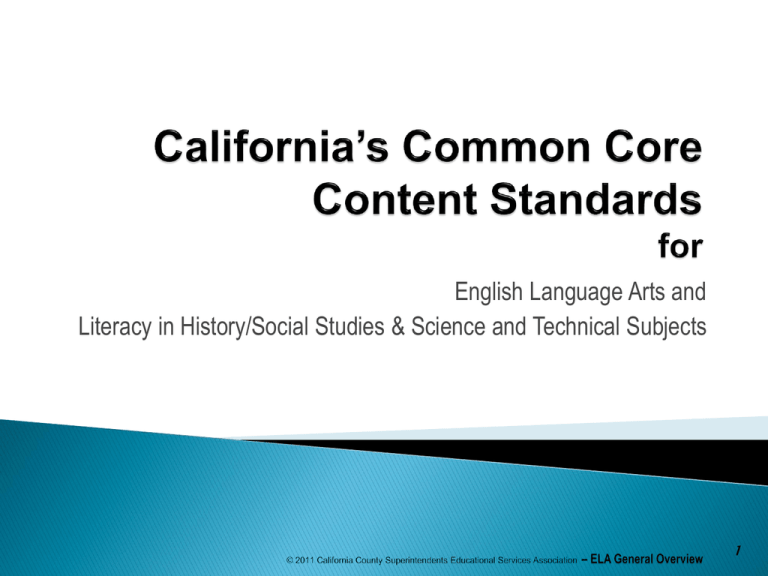
English Language Arts and Literacy in History/Social Studies & Science and Technical Subjects 1 Overview ◦ Key Design Considerations ◦ Additional 15% Organization Similarities Shifts Areas of Emphasis 2 Build toward preparing students to be college and career ready in literacy by no later than the end of high school Provide a vision of what it means to be a literate person in the twenty-first century Develop the skills in reading, writing, speaking, and listening that are foundational for any creative and purposeful expression in language 3 English Language Arts (ELA) ◦ ◦ ◦ ◦ Reading Writing Speaking & Listening Language Literacy in History/Social Studies & Science and Technical Subjects ◦ K-5: Embedded in ELA ◦ 6-12: Separate section 4 College and Career Readiness (CCR) anchor standards Grade levels for K-8; grade bands for 9-10 and 11-12 A focus on results rather than means An integrated model of literacy Research and media skills integrated into the Standards as a whole Shared responsibility for students’ literacy development Focus and coherence in instruction and assessment 5 Note what the Standards DO and DO NOT cover The Standards DO… The Standards DO NOT… set grade-level standards define the intervention methods or materials allow for the widest possible range of students to participate fully permitting appropriate accommodations define the full range of supports appropriate for English learners and students with special needs define general, cross-disciplinary literacy expectations define the whole of college and career readiness 6 Note what the Standards DO and DO NOT cover The Standards DO… The Standards DO NOT… define what all students are expected to know and be able to do define how teachers should teach focus on what is most essential describe all that can or should be taught establish a baseline for advanced learners define the nature of advanced work 7 Substantively enhance Address a perceived gap Be defensible to classroom practitioners Keep the original standard intact Ensure the rigor of California’s existing standards is maintained 8 Analysis of text features in informational text (Gr. 6-12) Career and consumer documents included in Writing (Gr. 8) “Both in isolation and in text” added to the application of phonics and word analysis skills (Gr. K-3) Penmanship added to Language (Gr. 2-4) Formal presentations included in Speaking and Listening (Gr. 1-12) Minor additions and insertions to enhance and clarify (e.g., archetypes, thesis) 9 Three main sections ◦ A comprehensive K-5 section ◦ Two content-area specific sections for grades 6-12 English Language Arts History/Social Studies & Science and Technical Subjects Four strands ◦ ◦ ◦ ◦ Reading Writing Speaking and Listening (K-12 ELA only) Language (K-12 ELA only) 10 Subheadings are consistent across grade levels within each set of standards Locate the handout at the back of your packet 11 K-12 grade-specific standards define end-of-year expectations A cumulative progression designed to enable students to meet college and career readiness expectations no later than the end of high school 13 College and Career Readiness - Anchor Standard 2 Determine central ideas or themes of a text and analyze their development; summarize the key supporting details. Standard 2 - Note the progression across grade levels: Kindergarten: With prompting and support, identify the main topic and retell key details of a text. Grade 2: Identify the main topic of a multi-paragraph text as well as the focus of specific paragraphs within the text. Grade 4: Determine the main idea of a text and explain how it is supported by key details; summarize the text. 14 Note the progression across grade levels: Grade 6: Determine a central idea of a text and how it is conveyed through particular details; provide a summary of the text distinct from personal opinions or judgments. Grade 8: Determine a central idea of a text and analyze its development over the course of the text, including its relationship to supporting ideas; provide an objective summary of the text. Grades 11-12: Determine two or more central ideas of a text and analyze their development over the course of the text, including how they interact and build on one another to provide a complex analysis; provide an objective summary of the text. 15 Current CA Standards DOMAINS • • • • Reading Writing Listening and Speaking Written and Oral English Language Conventions Common Core Standards for CA STRANDS • • • • Reading Writing Speaking and Listening Language 16 California Standard Common Core Standard for California 1st Grade Writing 2.1 Write brief narratives (e.g., fictional, autobiographical) describing an experience. 1st Grade Writing 3. Write narratives in which they recount two or more appropriately sequenced events, include some details regarding what happened, use temporal words to signal event order, and provide some sense of closure. 3rd Grade Reading 2.3 Demonstrate comprehension by identifying answers in the text. 3rd Grade Reading Standards for Informational Text 1. Ask and answer questions to demonstrate understanding of a text, referring explicitly to text as the basis for the answers. 17 California Standard Common Core Standard for California 6th Grade Reading 2.7 Make reasonable assertions about a text through accurate, supporting citations. 6th Grade Reading Standards for Informational Text (ELA) 1. Cite textual evidence to support analysis of what the text says explicitly as well as inferences drawn from the text. Reading Standards for Literacy in History/Social Studies 1. Cite specific textual evidence to support analysis of primary and secondary sources. Reading Standards for Literacy in Science and Technical Subjects 1. Cite specific textual evidence to support analysis of science and technical texts. 18 California Standard Common Core Standard for California 9th/10th Grade Reading 2.1 Analyze the structure and format of functional workplace documents, including the graphics and headers, and explain how authors use the features to achieve their purposes. 9th/10th Grade Reading Standards for Informational Text 5. Analyze in detail how an author’s ideas or claims are developed and refined by particular sentences, paragraphs, or larger portions of a text (e.g., a section or chapter). a. Analyze the use of text features (e.g., graphics, headers, captions) in functional workplace documents. 19 Standard California: Domain Common Core Standard for California: Strand Vocabulary Reading Language Conventions/Grammar Written and Oral English Language Conventions Language 20 Common Core Standards for CA 1.Write Opinions (K-5); Write Arguments (6-12) 2.Write Informative/Explanatory Texts 3.Write Narratives CA Standards 1. Narratives 2. Expository Descriptions 3. Friendly Letters 4. Personal or Formal Letters 5. Response to Literature 6. Information Reports 7. Summaries 8. Persuasive Letters/Compositions 9. Research Reports 10. Fictional Narratives 11. Biographical/Autobiographical Narratives 12. Career Development Documents 13. Technical Documents 14. Reflective Compositions 15. Historical Investigation Reports 16. Job Application/Resume 21 The Standards cultivate three mutually reinforcing writing capacities: To persuade To explain To convey real or imagined experience Distribution of Communicative Purposes by Grade in the 2011 NAEP Writing Framework Grade To Persuade To Explain To Convey Experience 4 30% 35% 35% 8 35% 35% 30% 12 40% 40% 20% 22 A single K-5 set of grade-specific standards ◦ Most or all of the instruction students receive comes from one teacher Two content area–specific sections for grades 6-12 ◦ One set of standards for ELA teachers ◦ One set of standards for history/social studies, science, and technical subject teachers The literacy standards in history/social studies, science, and technical subjects are meant to complement rather than supplant content standards in those disciplines 23 Focus on text complexity Address reading and writing across the curriculum Emphasize analysis of informational text Focus on writing arguments and drawing evidence from sources Emphasize participating in collaborative conversation Integrate media sources across standards 24 Reading standards place equal emphasis on the sophistication of what students read and the skill with which they read Standard 10 defines a grade-by-grade “staircase” of increasing text complexity that rises from beginning reading to the college and career readiness level 25 Writing, Grade 5 9. Draw evidence from literary or informational texts to support analysis, reflection, and research. a) Apply grade 5 Reading standards to literature (e.g., “Compare and contrast two or more characters, settings, or events in a story or a drama, drawing on specific details in the text [e.g., how characters interact]”). b) Apply grade 5 Reading standards to informational texts (e.g., “Explain how an author uses reasons and evidence to support particular points in a text, identifying which reasons and evidence support which point[s]”). 26 Writing, Grades 9-10 English Language Arts 9. Draw evidence from literary or informational texts to support analysis, reflection, and research. a) b) Apply grades 9–10 Reading standards to literature (e.g., “Analyze how an author draws on and transforms source material in a specific work [e.g., how Shakespeare treats a theme or topic from Ovid or the Bible or how a later author draws on a play by Shakespeare]”). Apply grades 9–10 Reading standards to literary nonfiction (e.g., “Delineate and evaluate the argument and specific claims in a text, assessing whether the reasoning is valid and the evidence is relevant and sufficient; identify false statements and fallacious reasoning”). History/Social Studies, Science, and Technical Subjects 9. Draw evidence from informational texts to support analysis, reflection, and research. 27 The Standards aim to align instruction with this National Assessment of Educational Progress (NAEP) framework Distribution of Literary and Informational Passages by Grade in the 2009 NAEP Reading Framework Grade Literary Information 4 50% 50% 8 45% 55% 12 30% 70% Percentages do not imply that high school ELA teachers must teach 70% informational text; they demand instead that a great deal of reading should occur in other disciplines 28 Writing, Grade 7 1. Write arguments to support claims with clear reasons and relevant evidence. a) Introduce claim(s), acknowledge alternate or opposing claims, and organize the reasons and evidence logically. b) Support claim(s) with logical reasoning and relevant evidence, using accurate, credible sources and demonstrating an understanding of the topic or text. c) Use words, phrases, and clauses to create cohesion and clarify the relationships among claim(s), reasons, and evidence. d) Establish and maintain a formal style. e) Provide a concluding statement or section that follows from and supports the argument presented. 29 Speaking and Listening, Grade 5 1. Engage effectively in a range of collaborative discussions (one-on-one, in groups, and teacher-led) with diverse partners on grade 5 topics and texts, building on others’ ideas and expressing their own clearly. a) Come to discussions prepared, having read or studied required material; explicitly draw on that preparation and other information known about the topic to explore ideas under discussion. b) Follow agreed-upon rules for discussions and carry out assigned roles. c) Pose and respond to specific questions by making comments that contribute to the discussion and elaborate on the remarks of others. d) Review the key ideas expressed and draw conclusions in light of information and knowledge gained from the discussions. 30 Grade 6 Examples Across the Strands Reading Standards for Informational Text 7. Integrate information presented in different media or formats (e.g., visually, quantitatively) as well as in words to develop a coherent understanding of a topic or issue. Writing Standards 6. Use technology, including the Internet, to produce and publish writing as well as to interact and collaborate with others; demonstrate sufficient command of keyboarding skills to type a minimum of three pages in a single sitting. Speaking and Listening Standards 5. Include multimedia components (e.g., graphics, images, music, sound) and visual displays in presentations to clarify information. 31 Introduction College and Career Readiness Standards ELA Appendices ◦ Appendix A: Research Supporting Key Elements of the Standards ◦ Appendix B: Illustrative Texts Exemplars illustrating the complexity, quality, and range of reading appropriate for various grade levels ◦ Appendix C: Samples of Student Writing Annotated writing samples demonstrating adequate performance at various grade levels 32 Websites ◦ Common Core State Standards www.corestandards.org ◦ California’s Common Core Content Standards www.scoe.net/castandards 33

